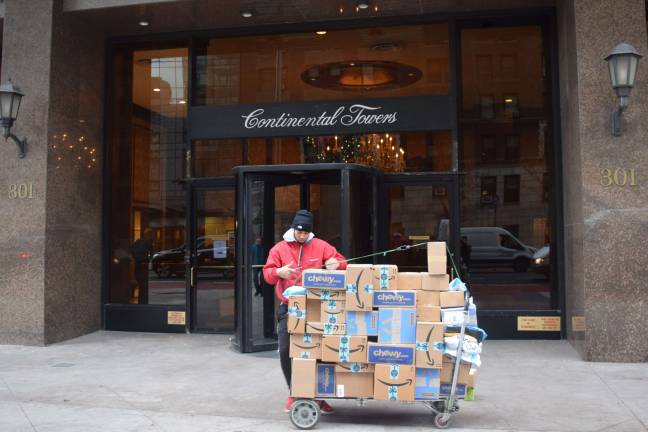Holiday package boom

By Michael Garofalo
It’s the most wonderful time of the year. But not for the doorman at an East 80th Street condominium building.
“It sucks,” he said with a wry smile, gesturing to a row of cabinets in the building’s lobby filled with residents’ package deliveries.
As New Yorkers increasingly rely on Internet retailers for their holiday shopping, he said, doormen are often left holding the box. “It’s definitely more emphasized at Christmas, but I see it throughout the year,” said the doorman, who asked that his name not be used. “As the years have gone by, we’re getting more and more stuff.”
“It makes my work harder, which, like anybody else, I’m not particularly thrilled about.”
The number of packages on a typical day in December is “crazy—at least double, sometimes triple the rest of the year,” according to another doorman at a nearby Yorkville co-op who also requested anonymity, but took a more ambivalent position on the increased workload. “Sometimes it’s good,” he said with a shrug. “If there’s nothing going on, a package can occupy you. It all depends.”
John Santos, vice president of 32BJ and director of the union’s residential division, said that two decades ago, before online retail rose to prominence, doormen would typically field only a handful of deliveries each day, usually small packages and overnight envelopes. Today—as more than 40 percent of New Yorkers receive deliveries at home “at least a few times a week,” according to a 2017 study by the city’s Department of Transportation—building service workers find themselves handling everything from mattresses to appliances, not to mention perishable food items delivered by companies like FreshDirect and Blue Apron.
“Not only has the volume gone up but also the size of the packages has increased,” Santos said.
But as the online shopping boom has created more work for doormen, it has also created more jobs. “In really big complexes, I’ve seen instances where buildings have added staff just to keep up with the load,” Santos said.
“In certain buildings, the guys at the front door may spend all day just logging packages and then distributing them throughout the building,” he said, adding that it’s not uncommon for buildings to bring on temporary help to handle increased deliveries during the holiday season.
One such building is the AVONOVA, at 219 West 81st St., which has added a second doorman during the month of December for the last three years. Michael Carroll, the president of the building’s condominium board, said the extra coverage is necessary not just to handle the surge in package deliveries, but also the increased number of guests visiting residents’ homes for holiday parties. Expanded staffing allows one doorman to handle package deliveries while the other works the door and announces visitors.
Seasonal staffing changes are just one aspect of the building’s adjustments to the year-round reality of online retail. The building added cold storage four years ago to hold groceries, flowers and pharmaceutical deliveries, and has also expanded each of its two storage rooms in recent years. “We decided we needed extra storage when we saw packages being left by the doorman in the lobby, and we didn’t like that look,” he said, adding, “We might need to expand again because the package count just increases every year.”
E-commerce’s share of the U.S. retail market has more than doubled since 2009, according to U.S. Census Bureau data. Amazon’s October announcement that it would build new corporate offices in Long Island City brought renewed attention to the myriad impacts the online retail boom has had on life in Manhattan, from vacant storefronts reflecting the decline of brick-and-mortar retail to the increased proliferation of delivery trucks on city streets, which transportation experts often cite as a contributing factor to worsening congestion.
As residents in buildings without doormen have increasingly turned to Amazon Lockers and other remote package pickup services to receive deliveries and avoid package theft, full-service buildings have had to adjust operations to accommodate additional packages.
Margie Russell, executive director of the New York Association of Realty Managers, said she has worked with staff in residential buildings to streamline package handling. She recommends buildings deliver packages in batches to residents’ doors during designated hours or upon request rather than individually in the lobby. “It’s far more efficient than dealing with package after package at the desk in the evening, when it’s a high-security time,” Russell said. In many cases, she added, buildings can avoid hiring new staff and raising monthly maintenance fees by adjusting the hours of existing staff.
Michael D. Rothschild, vice present at AJ Clarke Real Estate, said that at older buildings without doormen or live-in superintendents, property managers have fewer options. Owners can install virtual doorman systems that allow operators to remotely monitor entrances via closed-circuit video feeds and grant access to delivery workers– “quite an expensive proposition”—but storage areas are virtually nonexistent in most prewar walkup apartment buildings. “Even if there were someone to leave it with, there would be nowhere for them to keep it,” Rothschild said.
Rothschild said that a number of his firm’s full-service buildings have adopted software that automatically notifies residents via text or email when a package arrives. “It just makes people more aware that something is waiting, and makes it more likely that they’ll quickly pick it up,” freeing up limited storage space, he said.
“We can’t change what people’s habits are, and we’re not looking to do that,” Rothschild said. “It’s a fact of life.”